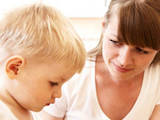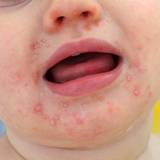Shop
01440
https://www.under5s.co.nz/shop/Hot+Topics+Articles/Health+%26+Wellbeing/Babies/What+can+babies+see.html
What can babies see?
|
There’s been lots of discussion about what babies can see from a young age and it’s something that has fascinated scientists for decades. We know that their eyes aren't fully developed when they’re born, but how long is it before their eye muscles start to develop and they can focus and see colour?
|
You might also be interested in ...
Anxiety in preschoolers
Kids of all ages have anxieties or worries of some kind. However, in most cases, anxiety in preschoolers is fairly transient and short-lived. Find out about some of the common causes of anxiety for preschoolers and ways you can help manage it.
Quick guide to hand foot & mouth disease
Hand, foot and mouth disease is usually caused by a viral infection. It can occur at any age, but is common in children under 10 years old. It is not the same as Foot and Mouth disease which occurs in farm animals. Read about the symptoms, how it is spread and how it can be treated.
join usJoin us on social media for all our latest news. |
sign upSign up and receive our latest newsletters. |
|







We know that their eyes aren't fully developed when they’re born, but how long is it before their eye muscles start to develop and they can focus and see colour?
What can babies see?
1. Your baby's eye sight
At birth, sight is the least developed of your baby's senses.
The ability to see objects and colours clearly depends on the development of the visual cortex, the maturity of the retina, coordination of the eye muscles and focusing ability.
Until these complex systems have matured, images, shapes and colours will appear blurry.
By 8 months of age, the ability to see clearly has nearly reached normal adult levels. The rapid pace of development is highly dependent on the amount of visual stimulation that a baby receives.
If a baby is deprived of visual stimulation, cells in the visual cortex may decrease or develop abnormally which can have serious implications for hand-eye coordination later on.
Other problems may include clumsiness, difficulties in concentrating and reading and writing problems when the child goes to school.
Even though a baby’s vision is not as developed as an adult’s this does not mean that they cannot see colours, patterns, shapes and objects at birth.
2. Common baby eye problems
Continual visual stimulation is so important in the early years.
Scientists suggest that sedentary activities such as watching TV can lead to near sightedness, focusing difficulties and other eye problems.
In the continued absence of visual stimulation, the brain may ignore or suppress images received from the retina, which can prevent vision from developing normally.
At present, eye problems affect 1 in 4 school age children.
Problems such as near sightedness, weak or misaligned eyes could be avoided by giving them plenty of opportunities to engage in action games and movement activities in a range of different surroundings early on.
Frequent eye checks in the first year are important. If a baby is unable to track or focus on an object by 3 or 4 months of age, then early detection and treatment could make all the difference.
Premature babies are at a greater risk of developing eye problems, so special attention should be paid to their sight.
3. Maturity of your baby's retina
At birth the amount of light collected is about 350 times less than that collected by the normal adult eye, so colour vision is very limited.
However, recent studies show that babies can see coloured patterns as long as there is enough contrast in colour and brightness.
They can also distinguish between two shades of grey that contrast by only 5 percent, which is about half as good as adult sensitivity.
It is thought that babies can see details more easily in dim light. Sensitivity to black and white is about one tenth that of the adult eye; the outline of their parent’s face, the dark shape of the pupil and bold black and white patterns present the highest possible contrast to the eye.
By 2 months of age, babies can usually see colours and the outlines of shapes ten times better than at birth.
A baby’s visual acuity at this stage is about 10/100 adult vision. Even though the brain and eye areas responsible for vision are still immature, the ability to distinguish between one colour and another develops rapidly.
In turn they become receptive to rich, bright, highly saturated colours such as yellows and reds. Recognition of the colour green follows shortly after, although sensitivity to the colour blue takes a little longer.
By 3 months of age, a baby's eyes have made its most progress, and they can now see all colours, including blue.
Development is so rapid, that by 6 months of age, a baby has about 20/50 adult vision. They can tell the difference between pastel colours and similar colour shades such as yellow and orange.
By 8 months of age, babies can see all the subtle shades that make the world so rich and interesting. However, visual acuity (20/30) is not as sensitive as an adult’s since the receptors and nerves in the fovea are not yet fully mature.
By a baby’s first birthday, the fovea has a high density of cones and eye development is almost complete. However, it will take another 4 years or more before visual acuity reaches normal adult levels.
4. Your baby's eye muscle development
When we look at the world with 2 eyes, we see one complete picture (binocular vision). However, it takes a few months for a baby to co-ordinate their eye movements.
At first, one or both eyes may cross or wander in all directions. Eye teaming usually begins when a baby fixes on the parent’s face. Later, they will pay close attention to the movement of their hands, then their feet and hands.
By 2 months of age a baby can track the movement of an object, providing it is not too small and it is moving at a modest pace.
A baby will also look in the direction of their mother’s voice as she moves around the room and will follow her movements.
If visual stimulation is continually provided, eye movements will be well co-ordinated by 3 months of age.
A baby will be able to track the moving path of an object in a 180 degree arc and alternate their gaze between two objects.
By 6 months of age, the ability to track moving objects up and down and side to side may be fully mastered.
Muscle control in the early months is critical for the development of later hand/eye co-ordination.
If the eye muscles are weak or unequal in strength, then a baby may see two images instead of one.
In extreme cases, the brain may ignore visual input from the weak eye completely. The condition may be impossible to correct later on and hand-eye coordination may be severely affected.
5. Your baby's focusing ability
It was previously thought that newborns could only focus on objects at distances of 18 - 30cm away.
We now know that they can see objects at a distance from birth, but that the images appear to merge into each other.
This is because a newborn has not yet learned how to control the ciliary muscles, which automatically contract the lens to project the image on to the retina.
Even if a clear picture was projected on to the retina, the image will be blurred. This is because the visual cortex and the fovea are still immature.
Moving objects help the ciliary muscles to develop. Cot mobiles are particularly useful and moving objects and shapes outside a baby’s focusing range.
If visually stimulated, a baby will begin to see more clearly by 2 months of age. The ability to focus is usually refined by 4 months of age.
6. Your baby's depth perception
At birth, a baby’s image of the world is two dimensional or flat. As their eyes start to work together as a team, three-dimensional vision or depth perception develops.
Depth perception allows a baby to estimate the distance of an object in the environment and to respond accurately.
For example, if a ball is rolled towards a baby, they will judge its distance and speed and respond by holding out their arms to catch it.
Depth perception also allows a baby to tell what an object looks like from a different angle without turning it over.
Babies that spend long periods of time in front of the TV see images in two dimensions and have little opportunity to exercise depth perception or far vision.
Taking babies outside increases all aspects of visual development including the ability to see things at a distance.
Depth perception improves significantly once a baby starts to crawl. They will see an object across the room and attempt to move towards it, which helps develops far vision.
Depth perception also develops with the growing use of their hands. Bricks, stacking toys and nesting cups are particularly useful for enhancing hand-eye coordination at this stage.
More baby articles for you to enjoy
Source: Dr. Lin Day, Baby Sensory - providing baby sensory development classes around New Zealand.
Image source: nerdwallet